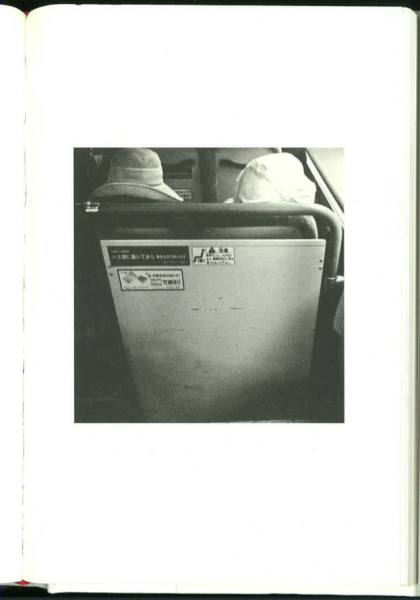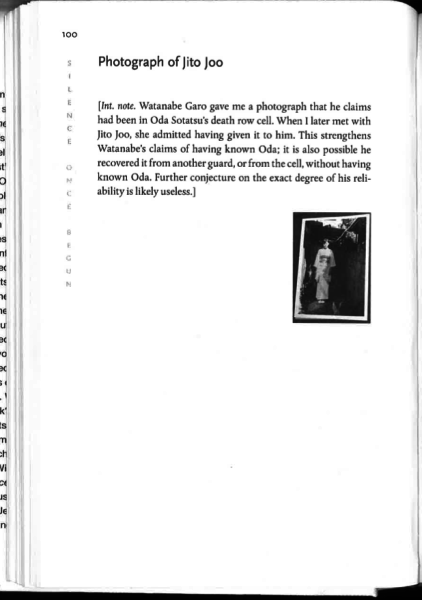Census opens with an untitled three-page preface, explaining how Ball’s brother had Down Syndrome, and how Ball had wanted to write about him, but decided to write a fictional narrative in which a father travels with his son, who has Down Syndrome. In that way, he says, he hoped to “allow others to see what such a boy is like, or can be like” (p. viii). The bulk of Census is that fiction. The book ends with another untitled section, this time just 14 pages of photographs with no captions. That section begins immediately after the novel concludes. By implication these are Ball’s own family photos.
A casual reader–by which I mean a partly disengaged reader, one willing to read quickly and for feeling rather than slowly and for structure–might be likely to find those photos moving. The untitled preface begins by saying the author’s brother died in 1998, and at the end of the novel, the boy’s father dies; given those deaths, and others in the novel, it might be enough to be reminded of the author’s own loss. But I think a more careful reading shows how problematic images can be when they are presented as things the author, rather than the narrator, has seen.
Midway through the novel, there is a section (pp. 112-120) where the narrator, the boy’s father, recounts some family photographs that his son had put up on his wall at home. The descriptions follow the photographs, more or less accurately, more or less in order. Some things in the photos are different from what’s described, but most are exactly the same. There are some indications Ball didn’t picture his readers turning back and forth and comparing descriptions with photos. Two of the photographs show three children, one with Down Syndrome, being pulled in a toy wagon (pp. 250-51). In the narrative, Ball’s narrator remarks “there is another boy who is in three [actually two] of the pictures. He lived across the way…” (p. 118). Here it seems Ball (not the narrator) has forgotten there are three children in the photos, perhaps because he was himself one of the children, so in his mind only one more child needed to be accounted for. But I don’t think this is what happened: I think he was assuming—strangely, to my way of thinking—that readers would not be looking at the photographs while they read pp. 112-120. By implication he is also assuming that his narrative, the imagination that went into it, will overwrite the photos. But how can a reader not think of the author, and of his photos, when she reads these pages? Perhaps a reader won’t notice or study the photos until she has finished the novel, but regardless of when she looks at the photos, she will think of this passage, and at some point every attentive reader will compare these pages to the photos.
I can think of three ways of encountering these images: (1) the reader continues in the fiction, and doesn’t notice the photographs until she finishes the novel; (2) the reader remembers looking at the photos, but doesn’t compare them to what’s described in these pages; (3) the reader compares the photos to the ekphrases. On the face of it, these are different possibilites, but they amount to analogous reading experiences in the end.
In my reading, it was a relief to come to the end of the pages describing photographs, because they were such a strong interruption in my reading. I was compelled to think of the author, rather than the fictional narrator. (I’m not objecting to metafiction here: I’m registering he fact that metafiction is not part of Bal’s novel except in these eight pages.) Each time I compared a photo to its description, I was in effect being asked to think about the author’s own imaginative process, and what he chose to alter. I was compelled to wonder what kind of reader he imagined–a reader, for example, who wouldn’t think about the photos until the end of the reading experience, who wouldn’t want to compare the photos to their descriptions. I think a careful reading has to show that Bal didn’t resolve the place or function of the images in Census as a whole.
Before I draw a conclusion from this, I want to mention anoyher example of the problems posed by photos presented as things the author has seen. Ball’s earlier book Silence Once Begun also has one section of images, also without words, but this time in the middle of the novel. When the reader comes to these pages she may assume at first they represent things the characters have seen, because the book is a mystery involving a trial, witnesses, and an inquiry. But the images are exactly what a non-Japanese tourist might photograph—indifferent scenes from a train, the backs of passengers’ heads, closed storefronts. For me, that section ends up being about Jesse Ball, the author, rather than the Jesse Ball who is identified as the narrator of the story. I imagine the author traveling around Japan, taking generic images that might work in his novel. I also imagine I am supposed to imagine the photographs are taken by the narrator, and that they are meant to express the narrator’s sense of loneliness and uncertainty; but the narrator has lived in Japan for a long time and would have access to many more specific, telling images. These seem more like snapshots taken on a short visit. The effect is jarring and, I think, unintended.
There are three other photographs in Silence Once Begun; one is a picture of a person who figures in the novel. It is part of the evidence the narrator is gathering. In this case, the picture is reproduced so small we can hardly see it, and it is apparently taken at an angle, carelessly, as if it had been hung on a wall. In the logic of the narrative there is no reason for that carelessness, because everything else in the story is so fastidiously presented (transcribed interviews, chronologies, even unpromising details). So the appearance of this one photograph so small on the page again takes me out of the fiction and reminds me of the author, who must be the one who decided we will not be able to see the woman clearly—as clearly as the narrator himself sees her, both in her picture and later in life.
In both Census and Silence once Begun, there is evidence Bal isn’t thinking about images. This is shown by a comment he made in an interview: “The photographic evidence.” he said, “is meant to strengthen and evoke not just the strangeness of seeing Japan, which is no stranger than any other place, but the general strangeness of seeing at all.” But the photographs in Silence once Begun are too much of the common 21st century aesthetic of indifference to express what he intends—they look too much like art student photographs. In a Brooklyn Rail interview he said that he wasn’t “there yet” with photography: “it could be that you need to have a faith in images, and I don’t have it.” If “faith” is read as “interest,” that accounts for the images in the book.
It is possible to mend the gap between fictional narratives images as things the author saw. In Census, for example, it would have been possible to add a first-person, nonfiction narrative to the closing section of images. Using the same voice with which he introduced his novel, Ball could have written some pages about the actual photographs, identifying some of the actual times and places. He could have written something about how he wrote pp. 112-20, and what he was thinking when he wrote those pages: what he wanted to salvage from the photographs, how he tried to write them into his fition, who he decided they needed to be reproduced even though they had already been presented in the fiction, what reality effect he hoped they might have, why he couldn’t initially bring himself to write anything about them, the extent to which they were private documents. Any of those or similar strategies might have built bridges between the fiction and its nonfictional frame, and would have helped heal the wound (“scab,” to use a metaphor from the novel) caused by the sudden intrusion, in the middle of the novel, of a very different kind of reading.
(More on this subject, in relation to Anne Carson, on the page An Attempt at Theory.)

